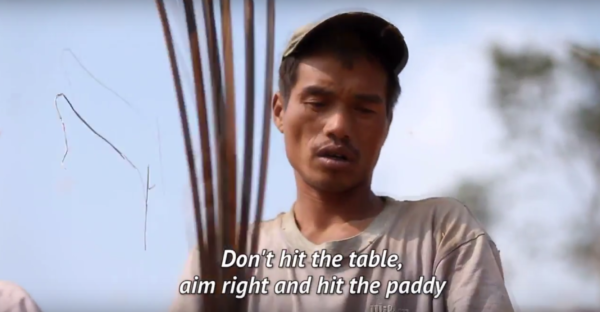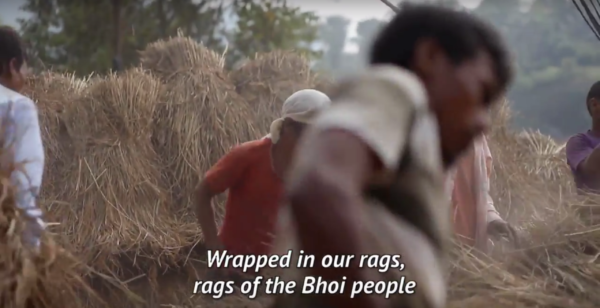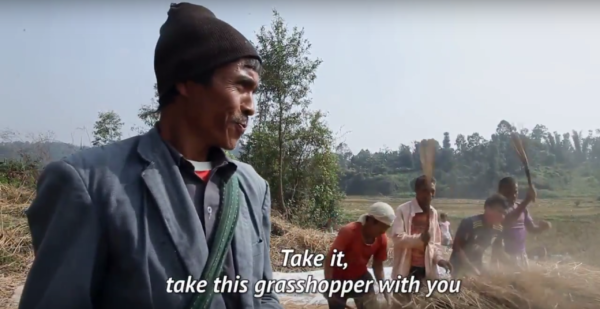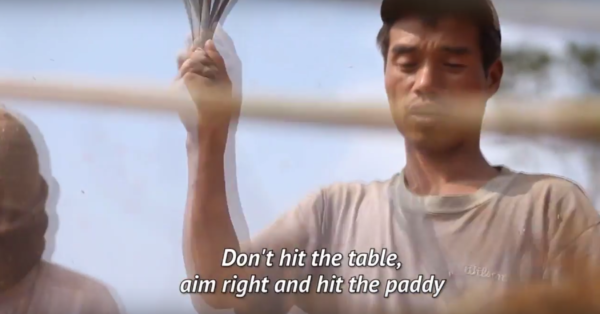Max Arne Kramer
Brief Life of Insects, Escaping Museums – Lak(h)empong Diaries, Sounds from the Truck Country and Kings Have Their Resorts, People Have Their Songs. These four titles of a series of six documentary films make you instantly wonder what may hold them together. Looking for orientation you could read the title of the film-series again – Songs to Live By – and perhaps find a synopsis saying that the films are dealing with indigenous communities in the North East of India. Perhaps you are even more puzzled now by the range of associations from fauna via commerce to state-institutions.
In some ways this series is an exploration of a new form of documentary by Shillong based Hindi poet, filmmaker and editor Tarun Bhartiya. His former filmic engagements include When the Hens Crow (2013) and Darjeeling Himalayan Railway (2010). He won the Indian National Film Award in editing for his work In Camera (2009). The two films he edited for Sanjay Kak Jashn-e-Azadi (2007) and Red Ants Dream (2013) are significant contributions to a cinema of resistance against the state driven violence in Kashmir and in the jungles of Odisha. Both films show a highly contextualized variation between ‚distancing effects’ and more realist representations of political struggle.
With the series on the North-East Bhartiya is exploring new grounds, both formally and in terms of a politics of representation. The titles already suggest that the series produced by the Meghalay Government Department of Arts and Culture is in some ways neither about art nor about culture. At least not in the way most of us would imagine a film to be about a culture or about a form of art. We may more fruitfully engage with this series as an attempt to take a close look at various song-performances and what they tell us about history, memory, power, and social transformation.
The songs seem to be part of a fragile memory that is fading in the rapidly changing societies of the North East. To give one example from the first film of the series „The Brief Life of Insects“. The farmer and musician Albinus Karkongor cannot remember a song he sang threshing paddy just a few months after the filmmaker captured a first performance of the paddy-song and asked him to sing it again for the camera. Even a recording that Bhartiya has done with his mobile phone was of no help to make Albinus remember the lyrics. The song was embedded into a bodily memory of the work on the field which is beautifully captured by the camera and the editing evoking the rhythm of the threshing while portraying the dynamics of the collective work.
In the last film of the cycle „Kings Have Their Resorts, People Have Their Songs“ the song Long Hai was restaged partly for the camera. A woman from Syndai asks: How can we preserve the song if we don’t cultivate millet. A voice from the side of the camera (perhaps the filmmaker) answers: You don’t have to actually cultivate millet. The song or tradition that has faded or is about to fade opens up questions of archive and preservation: who is recording for whom? Since hardly any written source exists in these oral traditions one further question becomes particularly interesting: what is the role of documentary film as an archive of these practices?
All films of the series are formally invested in the multi-sensorial experiences which go into the collective performances of these mostly work-related songs. There is the constant strive for gathering a sensibility not only of the particular – and sometimes lost – ritual context, but also of the films entanglement in the actualities that are produced through the camera. These interventions of the filmmaker are marked through subtle editing strategies that suggest how the presence of the film team re-invoked a ritual context gone by.
While the ritual setting of the Long Hai song was dependent on the harvest of millet, we see a group of women and men discussing how difficult it would be to re-stage this tradition in a time where betel nuts are produced for profit in Syndai. A telephone call from Shillong, the capital of Meghalaya, is signalling the distance of the filmmaker from the everyday context of Syndai and his interest to record something that is no longer practiced. However, some voices in his films make clear that what is gone is an absence that is felt as a lack. The new betel work has suspended a system of voluntary exchange of labour that has been central to the meaning of Long Hai. The films point towards a number of processes of commodification that have transformed the basis of living amongst the communities.
I understand this as the intervention of the filmmaker into a fragile memory. The camera gets entangled in the collective desire to restage something that is lost. But that ‘something’ is not framed within the familiar notion of culture as the way of life of a classifiable group. Instead, Bhartiyas films mobilise a lack from with-out by articulating an aesthetic potential of communality in a sceptical and always curious voice.
The titles of the films are:
- BRIEF LIFE OF INSECTS
22 mins | Ktien Nongtung with English subtitles
- LOVE SONGS OF SOTJAK AND RINGJENG
17 mins | A.chik with English subtitles
- ESCAPING MUSEUMS – LAK(H)EMPONG DIARIES
29 mins | Ktien Nongtung and Sohra Khasi with English subtitles
- SONGS & SECRETS IN SADOLPARA
20 mins | A.chik with English subtitles
- SOUNDS FROM THE TRUCK COUNTRY
39 mins | Pnar with English subtitles
- KINGS HAVE THEIR RESORTS, PEOPLE HAVE THEIR SONGS
40 mins | War Jaintia & Pnar with English subtitles
XIII. Kongress der Internationalen Vereinigung für Germanistik (IVG) in Shanghai, China, 24.–30. August 2015: Germanistik zwischen Tradition und Innovation.
Vortrag in der Sektion B18: „Literatur 2.0 – Produktion und Rezeption“
Konferenzbericht von Maria Rost
Seitdem Menschen reisen besteht das Bedürfnis, Eindrücke und Erlebnisse mündlich und schriftlich zu verarbeiten. Es verwundert deshalb nicht, dass der Reisebericht eine der ältesten Gattungen ist. Erste Spuren von erzählenden Berichten finden sich bereits in der griechischen Antike. Stand bis zum 16. Jahrhundert das berichtende Subjekt im Mittelpunkt, so erfuhren die Texte der Forschungsreisenden durch die wissenschaftliche Verarbeitung eine inhaltliche Differenzierung. Bis zum Aufkommen von Massentourismus und Massenmedien dienten Reiseberichte dazu, von fremden, für die meisten Menschen unerreichbaren Welten zu erzählen. Autor_innen von Reiseerzählungen nahmen ihr Lesepublikum mit auf imaginäre Erkundungen ferner geografischer Räume. Dabei orientierten sich die literarischen Texte in ihren Darstellungsverfahren an den gesellschaftlichen Leitmedien, dem Bild im 18. Jahrhundert, der Fotografie im 19. Jahrhundert oder dem Film im 20. Jahrhundert. Wie sieht das nun in der globalisierten und digitalisierten Welt des 21. Jahrhunderts aus? Diese und ähnliche Fragen stellten sich die siebzehn Referent_innen des Panels „Literatur 2.0“ des XIII. Kongress der Internationalen Vereinigung für Germanistik, die das Thema der Produktion und Rezeption aus der Perspektive unterschiedlichster Disziplinen beleuchteten.
Mein Vortrag zum Thema Neu trifft alt: Produktion und Rezeption der Destination Indien im Web 2.0 beschäftigte sich mit Beobachtungen und Interpretationen der Destination Indien in Online-Reiseberichten. Handelt es sich hier um authentische Berichte, die reale Sachverhalte darstellen, die individuell-subjektive ‚Realität‘ der Verfassenden abbilden und Zeugnis ablegen über Wahrnehmungsveränderungen der Destination Indien.
Unser gegenwärtiger Reisealltag ist von Medienpraktiken durchdrungen. Die Darstellungen der bereisten Destination Indien nehmen stetig zu und insbesondere das Web 2.0 ist ein Veröffentlichungsmedium, in dem Reiseberichte ein breites Publikum finden. Es werden neue Wege für die Produktion von Reiseberichten, und auch für ihre Rezeption, beschritten. Indien stellt diesbezüglich ein anschauliches Beispiel dar. In seiner ‚Andersartigkeit‘ regt es zur (Selbst-)Reflexion und dazu an, Reiseerfahrungen literarisch zu verarbeiten. Da Weblogs ein relativ neues Medium zur Beschreibung von Wahrnehmung und Darstellung sind, wurden diese näher betrachtet. Mein Vortrag hat Spezifika von Online-Reiseberichten am Beispiel der Destination Indien veranschaulicht, wobei die Frage im Zentrum stand, inwieweit sich die Rezeption veralteter Topoi wie beispielsweise ‚Betroffenheit‘ verändert – durch das Schreiben im Web 2.0. Wie wirken die individuellen Wahrnehmungen der Verfassenden von Online-Reiseberichten auf die Rezeption der Indiendarstellungen? In kurzen Analysen wurden spezifische Formen und Funktionen des Schreibens und Reflektierens im Web 2.0 an exemplarischen Einzelfalldarstellungen vorgestellt. Dabei wurde der Annahme nachgegangen, dass der Topos der ‚Fremde‘ nach wie vor existent ist, jedoch in den gewählten Online-Reiseberichten über Indien durch alternative Bilder einen Wandel erfährt und neben Differenz durchaus auch Ähnlichkeiten wahrgenommen werden.
Wenn wir uns Online-Reiseberichte als eine neue Form der Literatur anschauen, wirft das die Frage auf, in welcher intermedialen Beziehung die digitalen Medien des 21. Jahrhunderts zueinander stehen. Im Panel „Literatur 2.0“ wurden neue Formen der Literatur diskutiert und dabei die Frage verfolgt, inwieweit sich diese der traditionellen Printmedien bedienen und dabei auf ‚Digitalität‘ referieren, sie inszenieren oder simulieren. Es wurde diskutiert, welche Veränderungen in Produktion und Rezeption durch das Lesen an Bildschirmmedien wie eBooks, Tabletts, Smartphones und PCs sichtbar werden. Es ist und bleibt spannend zu entdecken, welche Entwicklung die Produktion und Rezeption von Literatur 2.0 nimmt und welche Wege sie – vielleicht als Literatur 2.5 – zukünftig beschreiten wird.
Mehr zum Kongress auf Deutschlandradio Kultur
26.08.2015 Goethe als Olympionike
Autor: Schmälzle, Christoph
Sendezeit: 10:47 Uhr
Länge: 05:28 Minuten
Nadja-Christina Schneider, Ringvorlesung Kultur und Identität am Institut für Asien- und Afrikawissenschaften der HU Berlin, 16. Juni 2015
[to loiter: herumbummeln, herumhängen, rumlungern]

Dass Frauen durch das vermeintlich zweckfreie „Herumlungern“ im öffentlichen Raum ihre Sichtbarkeit und Rechte als Bürgerinnen geltend machen können, ist die zentrale Idee des Essays „Why loiter? Radical possibilities for gendered dissent“ von Shilpa Phadke, Shilpa Ranade und Sameera Khan. Der Text erschien bereits 2009, also drei Jahre vor dem sog. Delhi Gang Rape Case, der die indische Öffentlichkeit aufwühlte und zu einer bis heute andauernden Debatte über die Sicherheit und Mobilität von Frauen im öffentlichen Raum geführt hat. Insbesondere vor dem Hintergrund der häufig vertretenen Ansicht, dass Frauen im Interesse ihrer eigenen Sicherheit ihre Mobilität möglichst einschränken sollten, wird „Why loiter?“ von jungen Frauen und Männern in Indien als Manifest und Aufforderung zur Handlung gelesen und multimedial umgesetzt.
Am Beispiel dieses Textes und seiner Wirkungsgeschichte gab der Vortrag von Nadja-Christina Schneider einen Einblick in den aktuellen Diskurs über „Gefahren“ für und „Sicherheit“ von Frauen im urbanen öffentlichen Raum in Indien. Der Vortrag wurde am 16. Juni 2015 im Rahmen der Ringvorlesung Kultur und Identität am Institut für Asien- und Afrikawissenschaften der HU Berlin gehalten.
Gastvortrag von Nina Khan am Institut für Indologie und Zentralasienwissenschaften der Universität Leipzig, 05.05.2015
 Der Vortrag führte zunächst in das Forschungsfeld der „Neuen Geber“ in der Entwicklungszusammenarbeit (EZ) ein und zeichnete aktuelle Entwicklungen und Debatten nach. Dabei wurde der langsame Umbruch der globalen Entwicklungshilfearchitektur – laut Woods (2008) eine „stille Revolution“ – skizziert und dessen Bedeutung nicht nur für strukturelle Veränderungen (wie z.B. die Diversifizierung der Geberlandschaft und die daraus resultierende größere Wahlmöglichkeit und stärkere Position der Nehmer) sondern auch für eine normative Pluralisierung der EZ konstatiert, die sich in Entwicklungsdiskursen wiederspiegelt.
Der Vortrag führte zunächst in das Forschungsfeld der „Neuen Geber“ in der Entwicklungszusammenarbeit (EZ) ein und zeichnete aktuelle Entwicklungen und Debatten nach. Dabei wurde der langsame Umbruch der globalen Entwicklungshilfearchitektur – laut Woods (2008) eine „stille Revolution“ – skizziert und dessen Bedeutung nicht nur für strukturelle Veränderungen (wie z.B. die Diversifizierung der Geberlandschaft und die daraus resultierende größere Wahlmöglichkeit und stärkere Position der Nehmer) sondern auch für eine normative Pluralisierung der EZ konstatiert, die sich in Entwicklungsdiskursen wiederspiegelt.
Drei Grundannahmen bildeten den Hintergrund der folgenden Diskussion aktueller Kernthemen des staatlichen indischen Entwicklungsdiskurses. Erstens, dass die Beziehungen der Nord-Süd-EZ nach wie vor von asymmetrischen, rassifizierten Machtbeziehungen gekennzeichnet sind, die durch Entwicklungsdiskurse gestützt werden. Zweitens, dass der Neue Geber Indien als ehemals kolonisiertes und weiterhin Empfängerland, das als solches lange Zeit als „unterentwickelt“ und „rückständig“ kategorisiert wurde, nicht dieselbe Entwicklungsrhetorik der traditionellen Geber des Globalen Nordens verwenden wird. Drittens, dass alternative, eventuell gleichberechtigtere Entwicklungsdiskurse einen Einfluss auf die Machtbeziehungen in der EZ haben können.
Nach einer Einführung in die Geschichte, Struktur und den Umfang indischer EZ erfolgte ein Einblick in eine exemplarische Analyse des staatlichen indischen Entwicklungsdiskurses. Diese ergab mehrere wiederkehrende Themen, die anhand von Zitaten aus Artikeln des Indischen Außenministeriums, Aussagen indischer Politiker_innen sowie Webseiten und Publikationen staatlicher Entwicklungsprogramme veranschaulicht wurden. Kernthemen sind dabei Reziprozität, die Abgrenzung von traditionellen Gebern sowie Geber-Nehmer-Beziehungen, die Betonung einer Entwicklungspartnerschaft und der eigenen Erfahrungen als „Entwicklungsland“, eine geteilte Kolonialgeschichte sowie eine propagierte Süd-Süd-Solidarität.
Abschließend aufgeworfene Fragen beinhalteten die Kongruenz von staatlicher Rhetorik und EZ-Praxis, das Potential alternativer Diskurse für diskursive Verschiebungen im globalen Kontext, eventuell abweichende Diskursstränge je nach Nehmerland bzw. –Region und die Auswirkungen diskursiver Verschiebungen auf die tatsächlichen Machtbeziehungen in der EZ.

Alexa Altmann
An ad recently published in The Hindu for the luxury brand Kalyan Jewellers has sparked a controversy over colonialism, racism, child-labour and slave-fantasies as well as over public image projection and accountability. The depiction of movie-star Aishwarya Rai Bachchan in the fashion of a European colonial-era aristocrat, bejeweled, poised and shaded from the sun by an undernourished black child-slave, has prompted the outrage of several feminist and child rights activists as expressed in an open letter to Rai Bachchan and Kalyan Jewellers. The authors equally draw attention to the racist implications of the slave fantasy depicted in the advertisement by referencing the colonial heritage of comparable historic portraitures and to the romanticisation of child servitude. While Kalyan Jewellers promptly issued an apology and withdrew the image, Rai Bachchan’s publicist declared the final layout featuring the black child-slave was edited without the actress’ knowledge and consent and thus only the responsibility of the brand’s creative team. The activists countered by questioning this statement and Rai Bachchan’s alleged lack of control over her own public image. They demand Rai Bachchan to take a clear stand, both as an icon and in her role as UN Ambassador, against racism and the trivialization of servitude as well as take full responsibility for the commercialization of her public image projection.
SCROLL.IN, 04 May, 2015
Ranjona Banerji
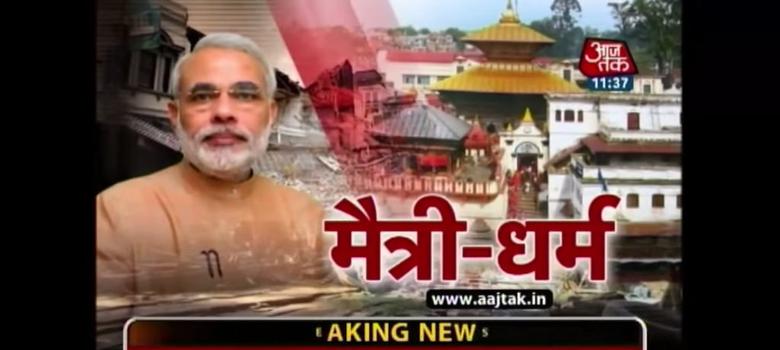
Social media and TV news in India have turned Nepal’s tragedy into a display of self-aggrandisement.
Over the weekend, the hashtag #GoHomeIndianMedia was the top trend on Twitter. The message came from the people of Nepal, who were sick of the way the Indian media was covering the earthquake of April 25.
In many ways, this was an international relations disaster waiting to happen and was foreseen by many. Almost as soon as the Indian media heard of the earthquake, bad journalism began. It started on Saturday morning with many anchors finding it difficult to fathom that an earthquake cannot be covered like a cricket match or a film release. It needed a bit of serious thinking and planning. But true to form, it became a contest between two impulses: to say “India is the greatest” and “I’m a better channel than you”.
The Indian government was indeed prompt to respond to the plight of Nepal, a neighbour and a very old friend with a shared heritage. The Indian Armed Forces is experienced in relief and rescue operations. But having done that, Indian nationalism on social media and on TV news went into chest-thumping overdrive. The focus was on the enormity of the Indian rescue effort and the personal involvement of Indian Prime Minister Narendra Modi. The implication was twofold: India was doing everything and Nepal was incapable. Add to that shoddy and sensationalist reportage, especially on television, where grieving survivors and their families were asked how they felt about the deaths they had witnessed or had heard about. As one person pointed out, earthquake victims felt they were being treated like characters in an Indian soap opera.
Geopolitical battle
The Indian media also took huge umbrage to the fact that Pakistan had sent Nepal either beef or packets of beef masala as part of their aid package. It did not occur to any of our televangelists that it was up to Nepal to be offended or grateful. We just cornered the problem as our own, decided that Nepal was upset because it was a “Hindu nation”. This, in the eyes of many Nepalis, turned their tragedy into our geopolitical battle.
But it was on social media that the nationalistic triumphalism was on full display. The fact that India had helped Nepal now had several subtexts. India had helped because of Modi’s efficiency. India had never helped anyone before Modi was sworn in. No other nation was helping so generously ‒ unsaid but by implication. The Indian Armed Forces were the greatest and more in the same vein. The Indian prime minister did not help by saying that his Nepalese counterpart had learnt about the earthquake from Modi’s Twitter account (although he did say that India felt Nepal’s pain).
For a person of Nepali origin, watching the aftermath of the earthquake on Indian television, the message was clear: Nepal would be finished if it wasn’t for India and Modi. Many TV channels had the Indian prime minister permanently on their screens as a backdrop. The backlash therefore was strong, with almost 60,000 tweets, according to some reports, carrying the hashtag #GoHomeIndianMedia.
Big Brother attitude
The reaction to this phrase in India was even more intriguing. Those who had warned that Indian self-congratulation on the aid to Nepal was trumping India’s generosity felt justified ‒ even if they had been slammed, threatened and abused roundly on social media at the time. Initially, a few right-wing social media regulars felt quite happy at this shaming of the media ‒ which they often categorise as “paid” or “presstitutes” and agents of every party but the Bharatiya Janata Party.
However their satisfaction soon turned to rage. The criticism of the media was seen as a criticism of India itself, which is oddly amusing given how the media is usually abused. But it was soon evident that the #GoHomeIndianMedia demand elliptically referred to India’s aid effort as well. Nepal’s editorials pointed out that many of the Indian rescue efforts were aimed at getting Indians to safety. The Indian media rode on Armed Forces vehicles when that space could have been used to help the people of Nepal. The anger harked back to Nepal’s old and simmering discontent about India’s patronising “big brother” attitude in the neighbourhood.
The right-wing on Twitter – which had in no small measure contributed to making India seem like an ungracious bully – now turned on Twitter itself and the people of Nepal. Some users wondered how the people of Nepal, under siege, managed to find the time and the internet connections to tweet their anger. The head of Twitter India was offensively and aggressively interrogated about where the hashtag originated from. The conspiracy theorists of the right-wing had returned to the same old bogey: it was evil, anti-national paid media Congress agents who had started this trend to malign Modi and his hard work. Thus, they denied the people of Nepal even that inalienable right to be angry when they wanted to. If any of these worthies had bothered to read any of Nepal’s newspapers or websites, they might have got an inkling of the mood in that country.
So here we are. A wonderful opportunity for selfless help in keeping with our high image of ourselves lies shattered around us. Each little shard mocks us for our failed attempt at self-aggrandisement. A little generosity of spirit would have served us a bit better, perhaps.
Read more at: #GoHomeIndianMedia was an international relations disaster waiting to happen
News » National
Published: January 16, 2015 08:08 IST | Updated: January 17, 2015 00:58 IST
Furore as Leela Samson quits
Even as the Government challenged Central Board of Film Certification (CBFC) `chairperson’ Leela Samson to prove her allegations, her decision to step down is expected to trigger a slew of resignations from the Board over the weekend. Already, one member, Ira Bhasker, is learnt to have stepped down.
Citing „interference, coercion’’ besides corruption of panel members and officers of the organization appointed by the Information & Broadcasting (I&B) Ministry, Ms. Samson sent in her resignation on Thursday night soon after word came that the Film Certification Appellate Tribunal (FCAT) had cleared the release of the film MSG – The Messenger of God featuring Dera Saccha Sauda chief Gurmeet Ram Rahim Singh Insan.
The film was initially scheduled for release today but was postponed after the `Examining Committee’ and the `Revising Committee’ of the CBFC rejected certification for the film. The `Revising Committee’ referred the film to FCAT last Tuesday and what has stunned Ms. Samson and other members of the Board is the speed at which the tribunal cleared the film.
„It usually takes FCAT several weeks to clear a film referred to it,’’ said one member who did not want to be quoted.
Meanwhile, the premiere of the film that was hurriedly sought to be organised in the satellite township of Gurgaon, adjoining Delhi, on Friday evening was cancelled at the eleventh hour as necessary formalities had not been completed. The Dera chief told his followers who had gathered there in large numbers that the date of the premiere and release of the film would be announced later. Prior to FCAT approval, the Dera had rescheduled the release of the film for January 23 but from what Ram Rahim told his followers that could also now change.
The FCAT’s decision drew sporadic protests in many parts of Punjab and Haryana. The Akal Takht had in December sought a ban on the movie by the godman who had first hurt the sentiments of the community when he had allegedly dressed up like the Sikh guru, Guru Gobind Singh. Several radical Sikh organizations like the Dal Khalsa and the Peer Mohammad faction of the All India Sikh Students Federation had also supported the demand then.
As the Government drew flak for the charges levelled by Ms. Samson, Union Minister of State for I&B Rajyavardhan Rathore countered by asking her to show a „letter or an SMS’’ to prove that the government had been ignoring the CBFC’s requests and preventing the Board from meeting for the past nine months. Two CBFC members confirmed to The Hindu that the Board had not met even once in the past nine months.
Ms. Samson’s three-year term and that of many of the Board members had ended in May 2014. In July, the Ministry had informed the Board members that their term was being extended „till further notice“.
Recently, the Board had also come under pressure from members of the Sangh Parivar over the Amir Khan-starrer `PK‘. At that point, Ms. Samson had gone on record stating that no scene from the film would be removed as it had already been released.
In the midst of the controversy, she had said over a fortnight ago that: „Every film may hurt religious sentiments of somebody or the other. We can’t remove scenes unnecessarily because there is something called creative endeavour where people present things in their own way. We have already given certificate to `PK‘ and we can’t remove anything now because it’s already out for public viewing.“
Keywords: Leela Samson, Censor Board, Messenger of God, Dera Saccha Sauda
View comments (74)
Printable version | Jan 17, 2015 12:28:48 PM | http://www.thehindu.com/news/national/censor-board-chief-leela-samson-decides-to-quit/article6792822.ece
© The Hindu
Related articles: PK Controversy: 5 reasons why the film must be banned (India Today)
PK: Controversies and laurels (The Hindu online)
There is a power shift in the portrayal of couples in brand marketing.
By Sunaina Kumar
Open Magazine, 10 November 2014
Of all media, advertising most likes to view men and women, especially women, as stock characters. The woman is usually circumscribed to the kitchen or bedroom—as the nitpicky housewife, the sacrificial mother, or the sexpot. It’s old hat to discuss advertising stereotypes. But, apart from selling products, sometimes advertising shows us the way we lead our lives, or the way we ought to. A series of commercials on television seem to be changing the contours of the most frequently used trope in advertising, that of the married couple.
Link to the article: http://www.openthemagazine.com/article/living/second-sex-hang-on
KOSMOS Workshop: Media, Social Movements and the New Indian Middle Class in India

Am 20. September 2014 findet am Institut für Asien- und Afrikawissenschaften ein internationaler Workshop zum Themenkomplex Medien, Gesellschaft und Politik im zeitgenössichen Indien statt. Neben Paper-Präsentationen soll es darin auch um den Austausch mit Kolleginnen über Fragen der Lehre gehen, insbesondere über die Frage, wie medienbezogene Themen und Fragestellungen darin vermittelt werden.
Das ausführliche Programm finden Sie hier:
KOSMOS Workshop 20 Sep 2014
Die Abstracts zu den einzelnen Vorträgen finden Sie hier:
List of Abstracts_KOSMOS Workshop
Kontakt und Anmeldung bis zum 13. September 2014: nadja-christina.schneider@asa.hu-berlin.de
Das 11. Indische Filmfestival in Stuttgart, 17.-20. Juli 2014
Ein Festivalbericht von Fritzi-Marie Titzmann und Alexandra Schott
Im Laufe einer Dekade hat sich das Indische Filmfestival in Stuttgart einen festen Platz in der Welt der indischen Filmfestivals in Europa und im jährlichen Kalender Indien-Begeisterter gesichert. Das Festival, das bis einschließlich 2011 unter dem Titel „Bollywood and Beyond“ lief, konnte auch in diesem Jahr wieder mit einem abwechslungsreichen Filmprogramm überzeugen. Das Rahmenprogramm reichte von den sogenannten „Tea Talks“, u.a. zur Parlamentswahl 2014 in Indien oder dem boomenden Online-Heiratsmarkt, über Tanzworkshops bis hin zu kleinen Musik- und Tanzvorführungen sowie dem Shah Rukh Khan Wunschfilm.
Das komplette Programm mit Kurzbeschreibungen zu allen Filmen findet sich unter:
www.indisches-filmfestival.de.
Lesen Sie den kompletten Bericht auf dem Informationsportal zu Südasien suedasien.info unter:



